HI5017 Managerial Accounting Assignment 1: Cost Concepts and Analysis
VerifiedAdded on 2023/03/31
|16
|3501
|156
Homework Assignment
AI Summary
This managerial accounting assignment solution addresses key cost concepts and their application in decision-making, using a child care business case study. The assignment analyzes relevant, fixed, and variable costs, providing calculations and recommendations for business decisions, such as outsourcing laundry services versus purchasing appliances, and hiring additional employees. It also includes a case study comparing Canon Inc. and Apple Computer Inc., along with a critique of a journal article on innovation management. The solution demonstrates an understanding of managerial accounting principles and their practical application to real-life business scenarios, including cost analysis, revenue projections, and profitability assessments to aid in strategic decision-making. The student provides detailed calculations, recommendations, and financial analyses to support the business decisions.
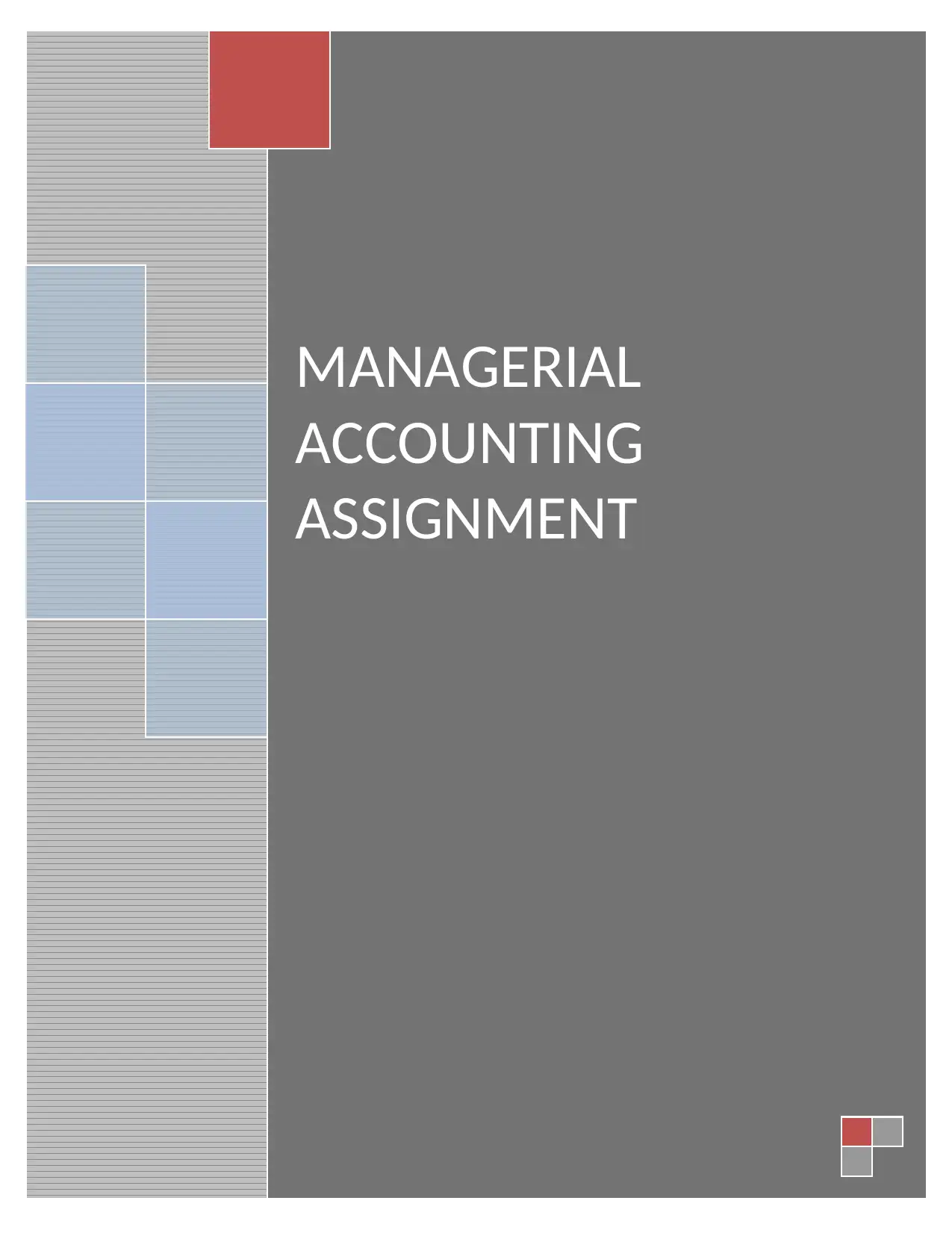
MANAGERIAL
ACCOUNTING
ASSIGNMENT
ACCOUNTING
ASSIGNMENT
Paraphrase This Document
Need a fresh take? Get an instant paraphrase of this document with our AI Paraphraser
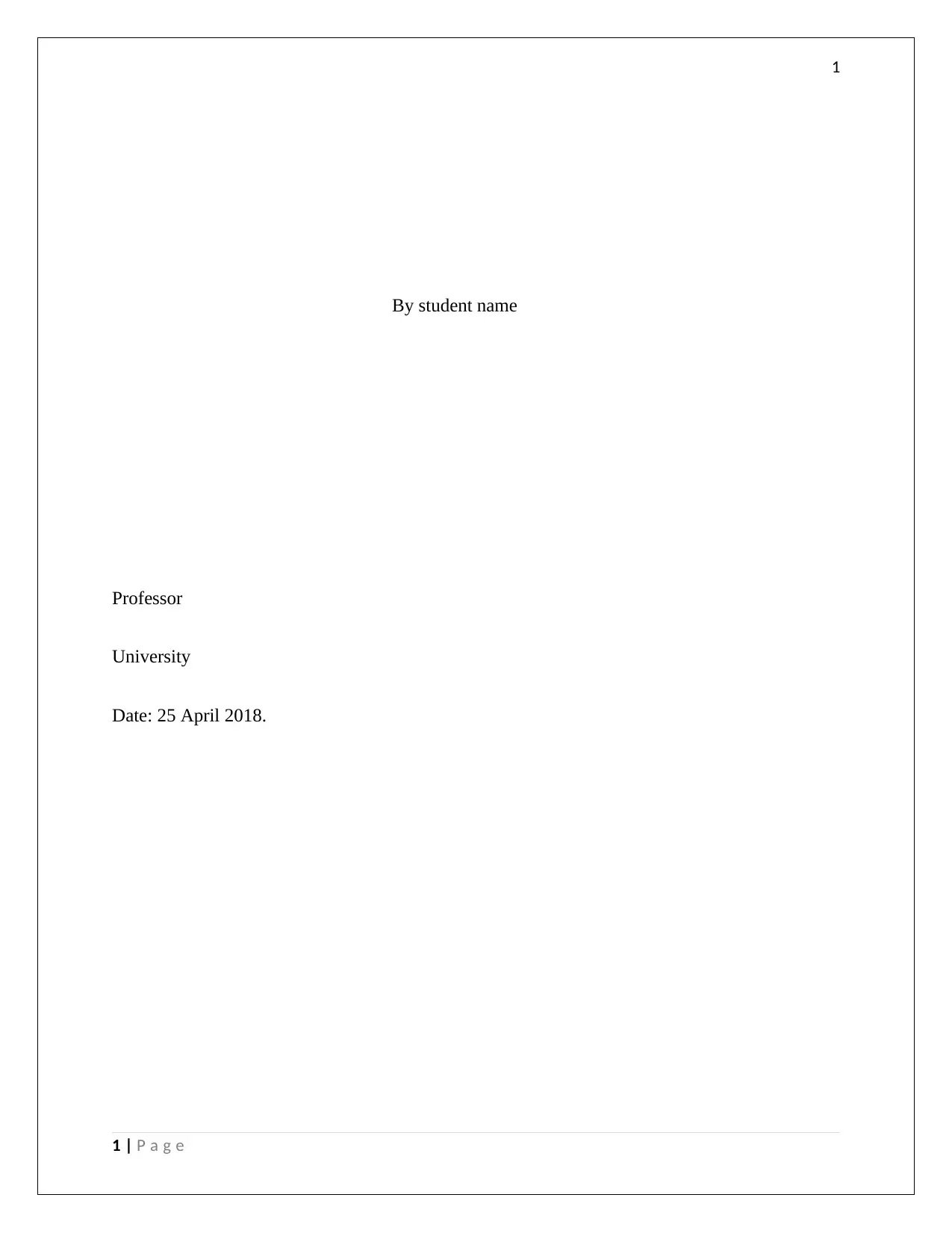
1
By student name
Professor
University
Date: 25 April 2018.
1 | P a g e
By student name
Professor
University
Date: 25 April 2018.
1 | P a g e
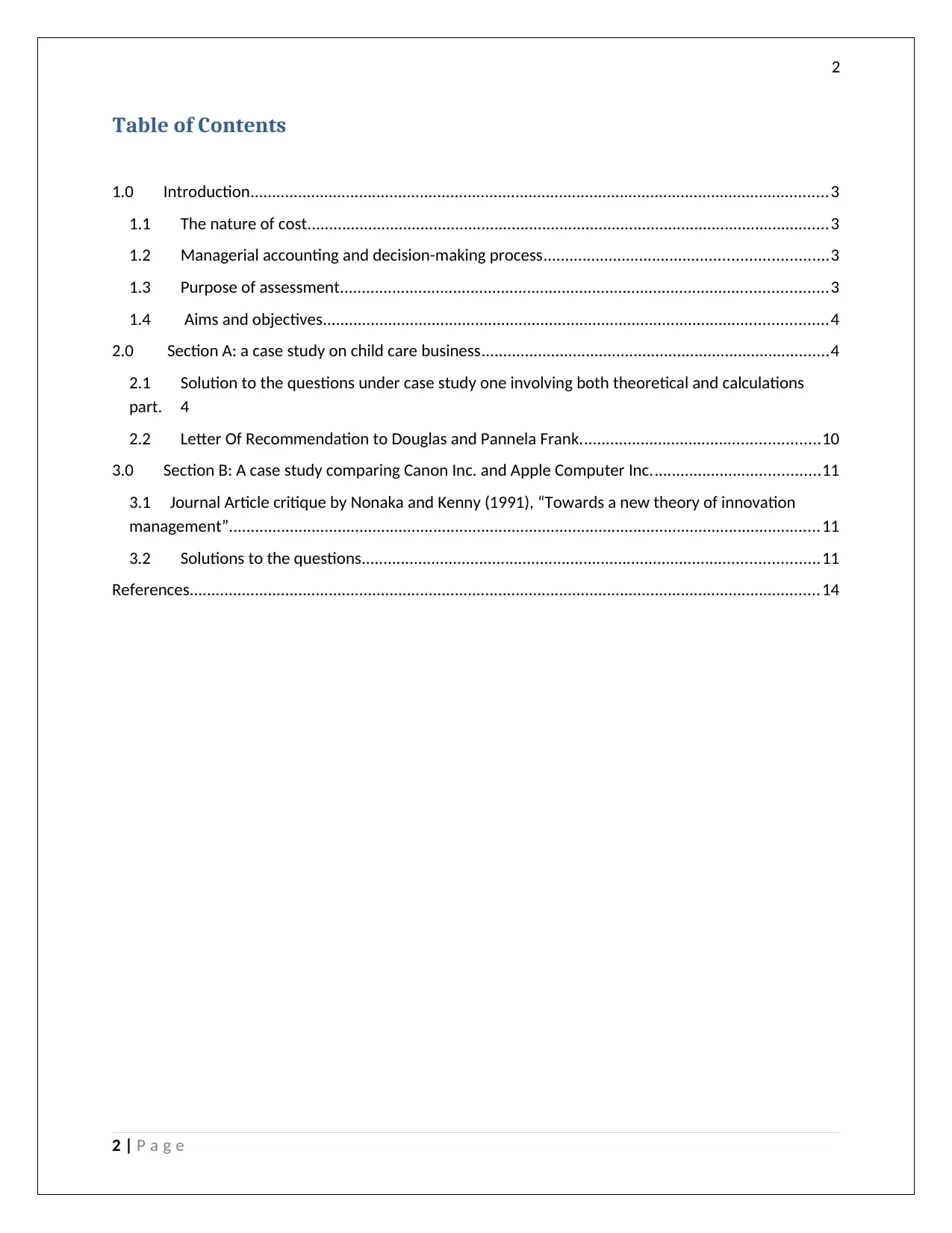
2
Table of Contents
1.0 Introduction.....................................................................................................................................3
1.1 The nature of cost........................................................................................................................3
1.2 Managerial accounting and decision-making process.................................................................3
1.3 Purpose of assessment................................................................................................................3
1.4 Aims and objectives....................................................................................................................4
2.0 Section A: a case study on child care business................................................................................4
2.1 Solution to the questions under case study one involving both theoretical and calculations
part. 4
2.2 Letter Of Recommendation to Douglas and Pannela Frank.......................................................10
3.0 Section B: A case study comparing Canon Inc. and Apple Computer Inc.......................................11
3.1 Journal Article critique by Nonaka and Kenny (1991), “Towards a new theory of innovation
management”........................................................................................................................................11
3.2 Solutions to the questions.........................................................................................................11
References.................................................................................................................................................14
2 | P a g e
Table of Contents
1.0 Introduction.....................................................................................................................................3
1.1 The nature of cost........................................................................................................................3
1.2 Managerial accounting and decision-making process.................................................................3
1.3 Purpose of assessment................................................................................................................3
1.4 Aims and objectives....................................................................................................................4
2.0 Section A: a case study on child care business................................................................................4
2.1 Solution to the questions under case study one involving both theoretical and calculations
part. 4
2.2 Letter Of Recommendation to Douglas and Pannela Frank.......................................................10
3.0 Section B: A case study comparing Canon Inc. and Apple Computer Inc.......................................11
3.1 Journal Article critique by Nonaka and Kenny (1991), “Towards a new theory of innovation
management”........................................................................................................................................11
3.2 Solutions to the questions.........................................................................................................11
References.................................................................................................................................................14
2 | P a g e
⊘ This is a preview!⊘
Do you want full access?
Subscribe today to unlock all pages.

Trusted by 1+ million students worldwide
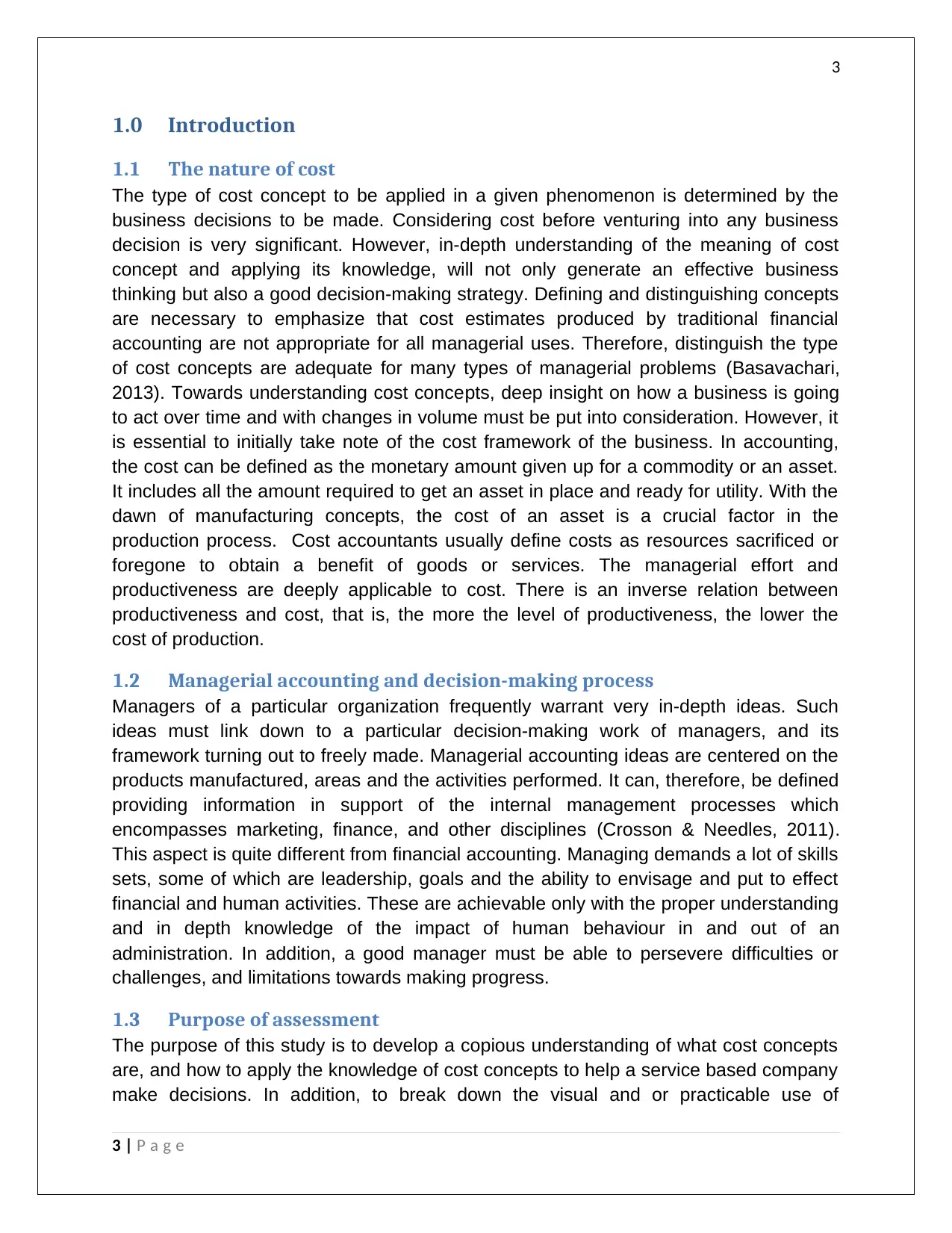
3
1.0 Introduction
1.1 The nature of cost
The type of cost concept to be applied in a given phenomenon is determined by the
business decisions to be made. Considering cost before venturing into any business
decision is very significant. However, in-depth understanding of the meaning of cost
concept and applying its knowledge, will not only generate an effective business
thinking but also a good decision-making strategy. Defining and distinguishing concepts
are necessary to emphasize that cost estimates produced by traditional financial
accounting are not appropriate for all managerial uses. Therefore, distinguish the type
of cost concepts are adequate for many types of managerial problems (Basavachari,
2013). Towards understanding cost concepts, deep insight on how a business is going
to act over time and with changes in volume must be put into consideration. However, it
is essential to initially take note of the cost framework of the business. In accounting,
the cost can be defined as the monetary amount given up for a commodity or an asset.
It includes all the amount required to get an asset in place and ready for utility. With the
dawn of manufacturing concepts, the cost of an asset is a crucial factor in the
production process. Cost accountants usually define costs as resources sacrificed or
foregone to obtain a benefit of goods or services. The managerial effort and
productiveness are deeply applicable to cost. There is an inverse relation between
productiveness and cost, that is, the more the level of productiveness, the lower the
cost of production.
1.2 Managerial accounting and decision-making process
Managers of a particular organization frequently warrant very in-depth ideas. Such
ideas must link down to a particular decision-making work of managers, and its
framework turning out to freely made. Managerial accounting ideas are centered on the
products manufactured, areas and the activities performed. It can, therefore, be defined
providing information in support of the internal management processes which
encompasses marketing, finance, and other disciplines (Crosson & Needles, 2011).
This aspect is quite different from financial accounting. Managing demands a lot of skills
sets, some of which are leadership, goals and the ability to envisage and put to effect
financial and human activities. These are achievable only with the proper understanding
and in depth knowledge of the impact of human behaviour in and out of an
administration. In addition, a good manager must be able to persevere difficulties or
challenges, and limitations towards making progress.
1.3 Purpose of assessment
The purpose of this study is to develop a copious understanding of what cost concepts
are, and how to apply the knowledge of cost concepts to help a service based company
make decisions. In addition, to break down the visual and or practicable use of
3 | P a g e
1.0 Introduction
1.1 The nature of cost
The type of cost concept to be applied in a given phenomenon is determined by the
business decisions to be made. Considering cost before venturing into any business
decision is very significant. However, in-depth understanding of the meaning of cost
concept and applying its knowledge, will not only generate an effective business
thinking but also a good decision-making strategy. Defining and distinguishing concepts
are necessary to emphasize that cost estimates produced by traditional financial
accounting are not appropriate for all managerial uses. Therefore, distinguish the type
of cost concepts are adequate for many types of managerial problems (Basavachari,
2013). Towards understanding cost concepts, deep insight on how a business is going
to act over time and with changes in volume must be put into consideration. However, it
is essential to initially take note of the cost framework of the business. In accounting,
the cost can be defined as the monetary amount given up for a commodity or an asset.
It includes all the amount required to get an asset in place and ready for utility. With the
dawn of manufacturing concepts, the cost of an asset is a crucial factor in the
production process. Cost accountants usually define costs as resources sacrificed or
foregone to obtain a benefit of goods or services. The managerial effort and
productiveness are deeply applicable to cost. There is an inverse relation between
productiveness and cost, that is, the more the level of productiveness, the lower the
cost of production.
1.2 Managerial accounting and decision-making process
Managers of a particular organization frequently warrant very in-depth ideas. Such
ideas must link down to a particular decision-making work of managers, and its
framework turning out to freely made. Managerial accounting ideas are centered on the
products manufactured, areas and the activities performed. It can, therefore, be defined
providing information in support of the internal management processes which
encompasses marketing, finance, and other disciplines (Crosson & Needles, 2011).
This aspect is quite different from financial accounting. Managing demands a lot of skills
sets, some of which are leadership, goals and the ability to envisage and put to effect
financial and human activities. These are achievable only with the proper understanding
and in depth knowledge of the impact of human behaviour in and out of an
administration. In addition, a good manager must be able to persevere difficulties or
challenges, and limitations towards making progress.
1.3 Purpose of assessment
The purpose of this study is to develop a copious understanding of what cost concepts
are, and how to apply the knowledge of cost concepts to help a service based company
make decisions. In addition, to break down the visual and or practicable use of
3 | P a g e
Paraphrase This Document
Need a fresh take? Get an instant paraphrase of this document with our AI Paraphraser
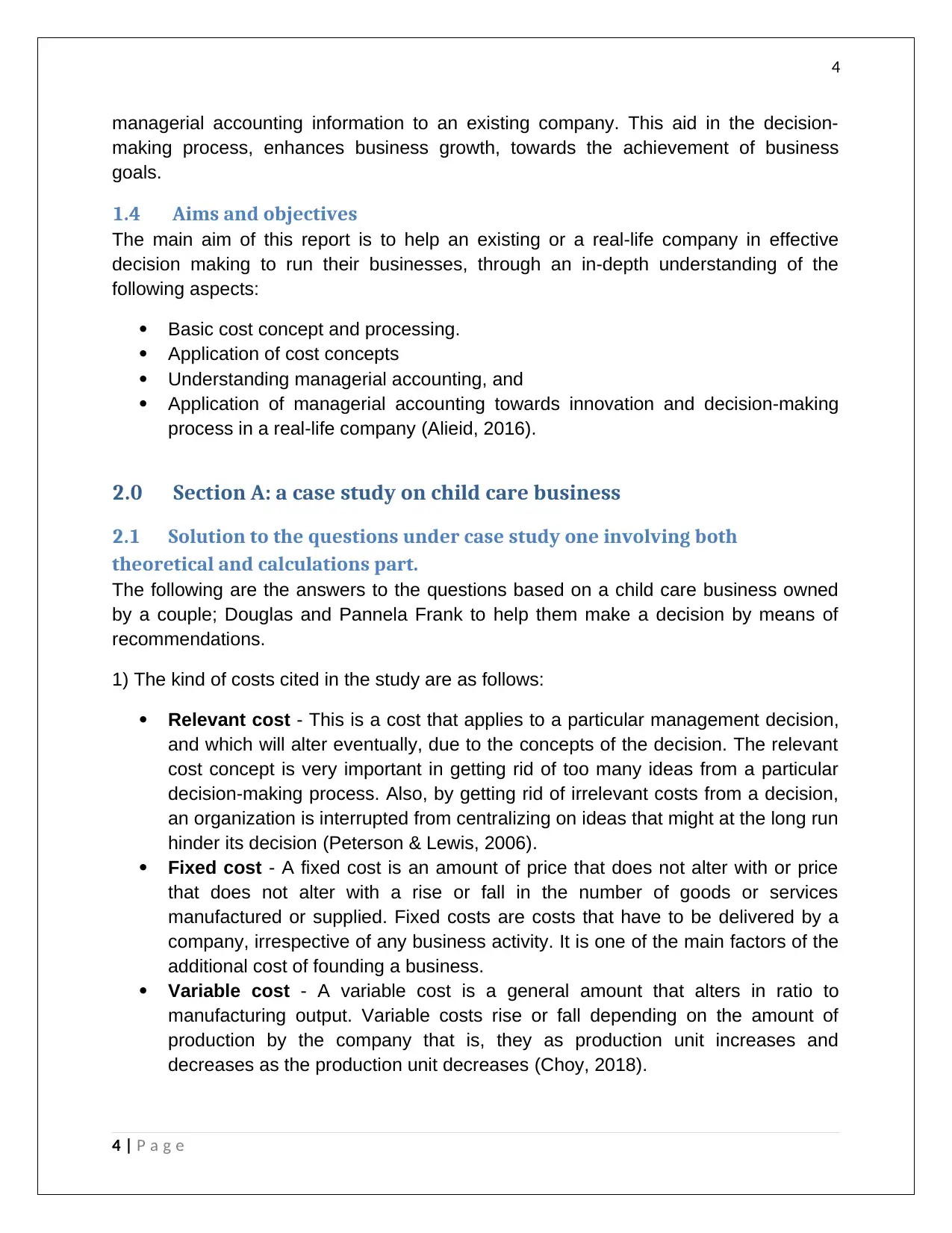
4
managerial accounting information to an existing company. This aid in the decision-
making process, enhances business growth, towards the achievement of business
goals.
1.4 Aims and objectives
The main aim of this report is to help an existing or a real-life company in effective
decision making to run their businesses, through an in-depth understanding of the
following aspects:
Basic cost concept and processing.
Application of cost concepts
Understanding managerial accounting, and
Application of managerial accounting towards innovation and decision-making
process in a real-life company (Alieid, 2016).
2.0 Section A: a case study on child care business
2.1 Solution to the questions under case study one involving both
theoretical and calculations part.
The following are the answers to the questions based on a child care business owned
by a couple; Douglas and Pannela Frank to help them make a decision by means of
recommendations.
1) The kind of costs cited in the study are as follows:
Relevant cost - This is a cost that applies to a particular management decision,
and which will alter eventually, due to the concepts of the decision. The relevant
cost concept is very important in getting rid of too many ideas from a particular
decision-making process. Also, by getting rid of irrelevant costs from a decision,
an organization is interrupted from centralizing on ideas that might at the long run
hinder its decision (Peterson & Lewis, 2006).
Fixed cost - A fixed cost is an amount of price that does not alter with or price
that does not alter with a rise or fall in the number of goods or services
manufactured or supplied. Fixed costs are costs that have to be delivered by a
company, irrespective of any business activity. It is one of the main factors of the
additional cost of founding a business.
Variable cost - A variable cost is a general amount that alters in ratio to
manufacturing output. Variable costs rise or fall depending on the amount of
production by the company that is, they as production unit increases and
decreases as the production unit decreases (Choy, 2018).
4 | P a g e
managerial accounting information to an existing company. This aid in the decision-
making process, enhances business growth, towards the achievement of business
goals.
1.4 Aims and objectives
The main aim of this report is to help an existing or a real-life company in effective
decision making to run their businesses, through an in-depth understanding of the
following aspects:
Basic cost concept and processing.
Application of cost concepts
Understanding managerial accounting, and
Application of managerial accounting towards innovation and decision-making
process in a real-life company (Alieid, 2016).
2.0 Section A: a case study on child care business
2.1 Solution to the questions under case study one involving both
theoretical and calculations part.
The following are the answers to the questions based on a child care business owned
by a couple; Douglas and Pannela Frank to help them make a decision by means of
recommendations.
1) The kind of costs cited in the study are as follows:
Relevant cost - This is a cost that applies to a particular management decision,
and which will alter eventually, due to the concepts of the decision. The relevant
cost concept is very important in getting rid of too many ideas from a particular
decision-making process. Also, by getting rid of irrelevant costs from a decision,
an organization is interrupted from centralizing on ideas that might at the long run
hinder its decision (Peterson & Lewis, 2006).
Fixed cost - A fixed cost is an amount of price that does not alter with or price
that does not alter with a rise or fall in the number of goods or services
manufactured or supplied. Fixed costs are costs that have to be delivered by a
company, irrespective of any business activity. It is one of the main factors of the
additional cost of founding a business.
Variable cost - A variable cost is a general amount that alters in ratio to
manufacturing output. Variable costs rise or fall depending on the amount of
production by the company that is, they as production unit increases and
decreases as the production unit decreases (Choy, 2018).
4 | P a g e
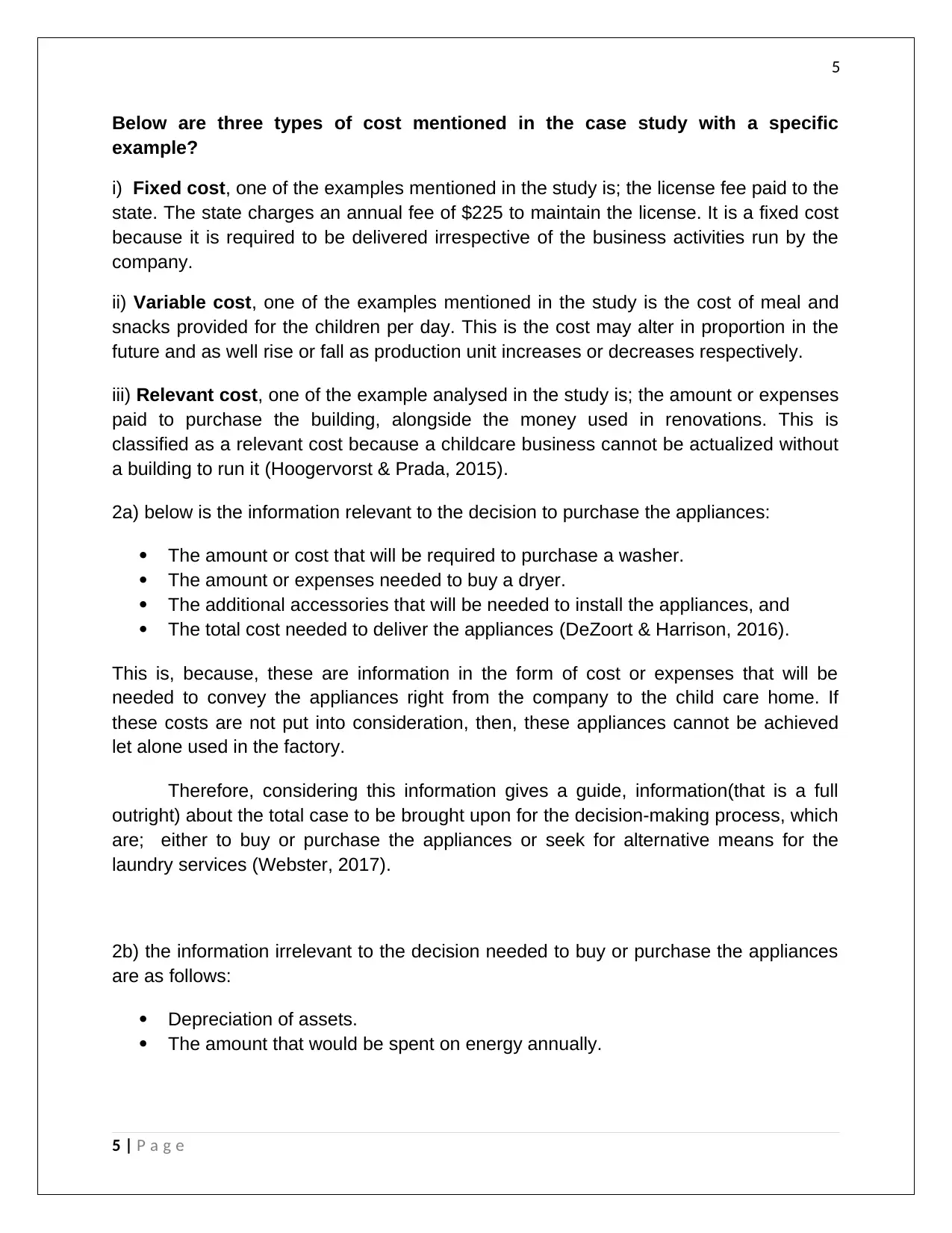
5
Below are three types of cost mentioned in the case study with a specific
example?
i) Fixed cost, one of the examples mentioned in the study is; the license fee paid to the
state. The state charges an annual fee of $225 to maintain the license. It is a fixed cost
because it is required to be delivered irrespective of the business activities run by the
company.
ii) Variable cost, one of the examples mentioned in the study is the cost of meal and
snacks provided for the children per day. This is the cost may alter in proportion in the
future and as well rise or fall as production unit increases or decreases respectively.
iii) Relevant cost, one of the example analysed in the study is; the amount or expenses
paid to purchase the building, alongside the money used in renovations. This is
classified as a relevant cost because a childcare business cannot be actualized without
a building to run it (Hoogervorst & Prada, 2015).
2a) below is the information relevant to the decision to purchase the appliances:
The amount or cost that will be required to purchase a washer.
The amount or expenses needed to buy a dryer.
The additional accessories that will be needed to install the appliances, and
The total cost needed to deliver the appliances (DeZoort & Harrison, 2016).
This is, because, these are information in the form of cost or expenses that will be
needed to convey the appliances right from the company to the child care home. If
these costs are not put into consideration, then, these appliances cannot be achieved
let alone used in the factory.
Therefore, considering this information gives a guide, information(that is a full
outright) about the total case to be brought upon for the decision-making process, which
are; either to buy or purchase the appliances or seek for alternative means for the
laundry services (Webster, 2017).
2b) the information irrelevant to the decision needed to buy or purchase the appliances
are as follows:
Depreciation of assets.
The amount that would be spent on energy annually.
5 | P a g e
Below are three types of cost mentioned in the case study with a specific
example?
i) Fixed cost, one of the examples mentioned in the study is; the license fee paid to the
state. The state charges an annual fee of $225 to maintain the license. It is a fixed cost
because it is required to be delivered irrespective of the business activities run by the
company.
ii) Variable cost, one of the examples mentioned in the study is the cost of meal and
snacks provided for the children per day. This is the cost may alter in proportion in the
future and as well rise or fall as production unit increases or decreases respectively.
iii) Relevant cost, one of the example analysed in the study is; the amount or expenses
paid to purchase the building, alongside the money used in renovations. This is
classified as a relevant cost because a childcare business cannot be actualized without
a building to run it (Hoogervorst & Prada, 2015).
2a) below is the information relevant to the decision to purchase the appliances:
The amount or cost that will be required to purchase a washer.
The amount or expenses needed to buy a dryer.
The additional accessories that will be needed to install the appliances, and
The total cost needed to deliver the appliances (DeZoort & Harrison, 2016).
This is, because, these are information in the form of cost or expenses that will be
needed to convey the appliances right from the company to the child care home. If
these costs are not put into consideration, then, these appliances cannot be achieved
let alone used in the factory.
Therefore, considering this information gives a guide, information(that is a full
outright) about the total case to be brought upon for the decision-making process, which
are; either to buy or purchase the appliances or seek for alternative means for the
laundry services (Webster, 2017).
2b) the information irrelevant to the decision needed to buy or purchase the appliances
are as follows:
Depreciation of assets.
The amount that would be spent on energy annually.
5 | P a g e
⊘ This is a preview!⊘
Do you want full access?
Subscribe today to unlock all pages.

Trusted by 1+ million students worldwide
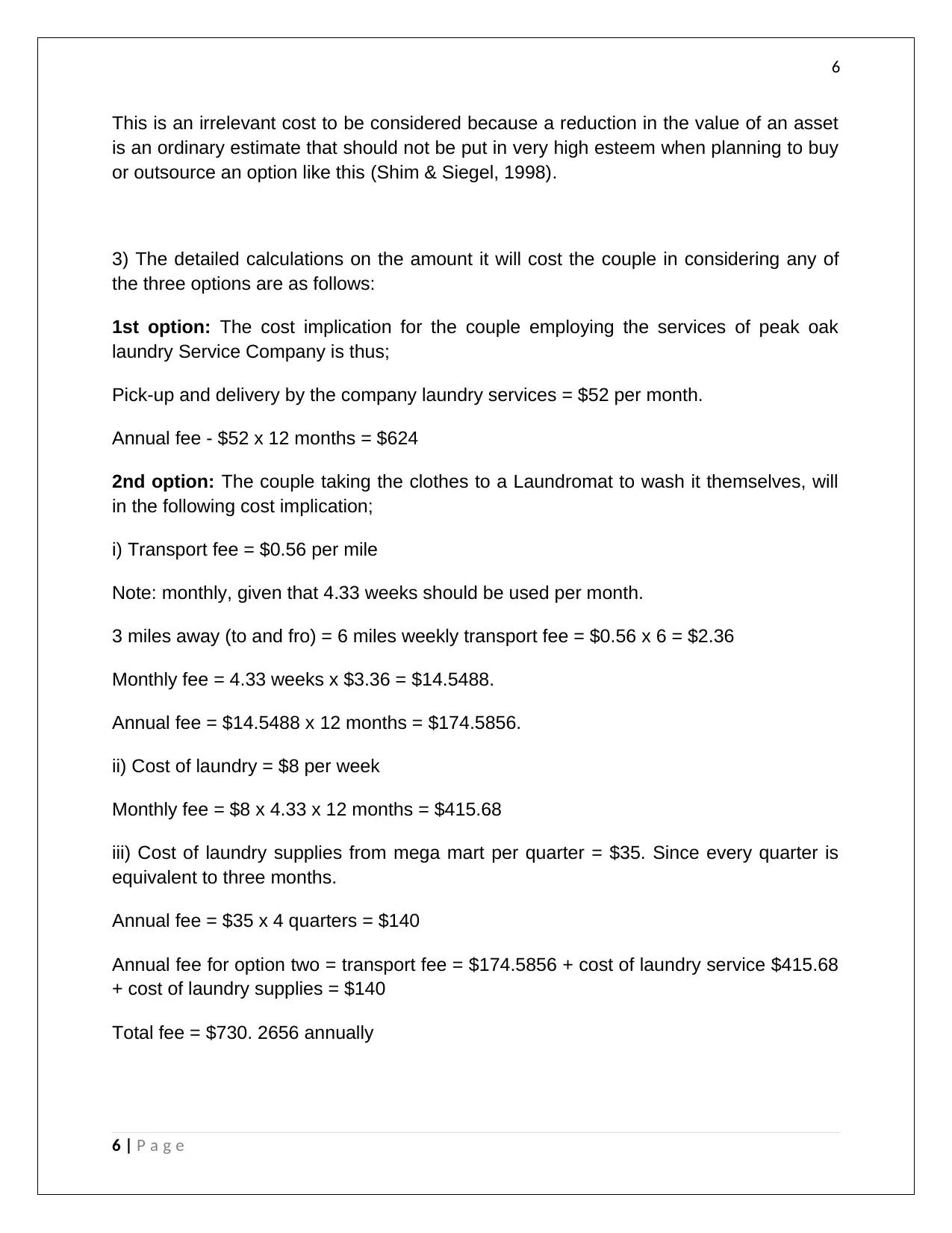
6
This is an irrelevant cost to be considered because a reduction in the value of an asset
is an ordinary estimate that should not be put in very high esteem when planning to buy
or outsource an option like this (Shim & Siegel, 1998).
3) The detailed calculations on the amount it will cost the couple in considering any of
the three options are as follows:
1st option: The cost implication for the couple employing the services of peak oak
laundry Service Company is thus;
Pick-up and delivery by the company laundry services = $52 per month.
Annual fee - $52 x 12 months = $624
2nd option: The couple taking the clothes to a Laundromat to wash it themselves, will
in the following cost implication;
i) Transport fee = $0.56 per mile
Note: monthly, given that 4.33 weeks should be used per month.
3 miles away (to and fro) = 6 miles weekly transport fee = $0.56 x 6 = $2.36
Monthly fee = 4.33 weeks x $3.36 = $14.5488.
Annual fee = $14.5488 x 12 months = $174.5856.
ii) Cost of laundry = $8 per week
Monthly fee = $8 x 4.33 x 12 months = $415.68
iii) Cost of laundry supplies from mega mart per quarter = $35. Since every quarter is
equivalent to three months.
Annual fee = $35 x 4 quarters = $140
Annual fee for option two = transport fee = $174.5856 + cost of laundry service $415.68
+ cost of laundry supplies = $140
Total fee = $730. 2656 annually
6 | P a g e
This is an irrelevant cost to be considered because a reduction in the value of an asset
is an ordinary estimate that should not be put in very high esteem when planning to buy
or outsource an option like this (Shim & Siegel, 1998).
3) The detailed calculations on the amount it will cost the couple in considering any of
the three options are as follows:
1st option: The cost implication for the couple employing the services of peak oak
laundry Service Company is thus;
Pick-up and delivery by the company laundry services = $52 per month.
Annual fee - $52 x 12 months = $624
2nd option: The couple taking the clothes to a Laundromat to wash it themselves, will
in the following cost implication;
i) Transport fee = $0.56 per mile
Note: monthly, given that 4.33 weeks should be used per month.
3 miles away (to and fro) = 6 miles weekly transport fee = $0.56 x 6 = $2.36
Monthly fee = 4.33 weeks x $3.36 = $14.5488.
Annual fee = $14.5488 x 12 months = $174.5856.
ii) Cost of laundry = $8 per week
Monthly fee = $8 x 4.33 x 12 months = $415.68
iii) Cost of laundry supplies from mega mart per quarter = $35. Since every quarter is
equivalent to three months.
Annual fee = $35 x 4 quarters = $140
Annual fee for option two = transport fee = $174.5856 + cost of laundry service $415.68
+ cost of laundry supplies = $140
Total fee = $730. 2656 annually
6 | P a g e
Paraphrase This Document
Need a fresh take? Get an instant paraphrase of this document with our AI Paraphraser
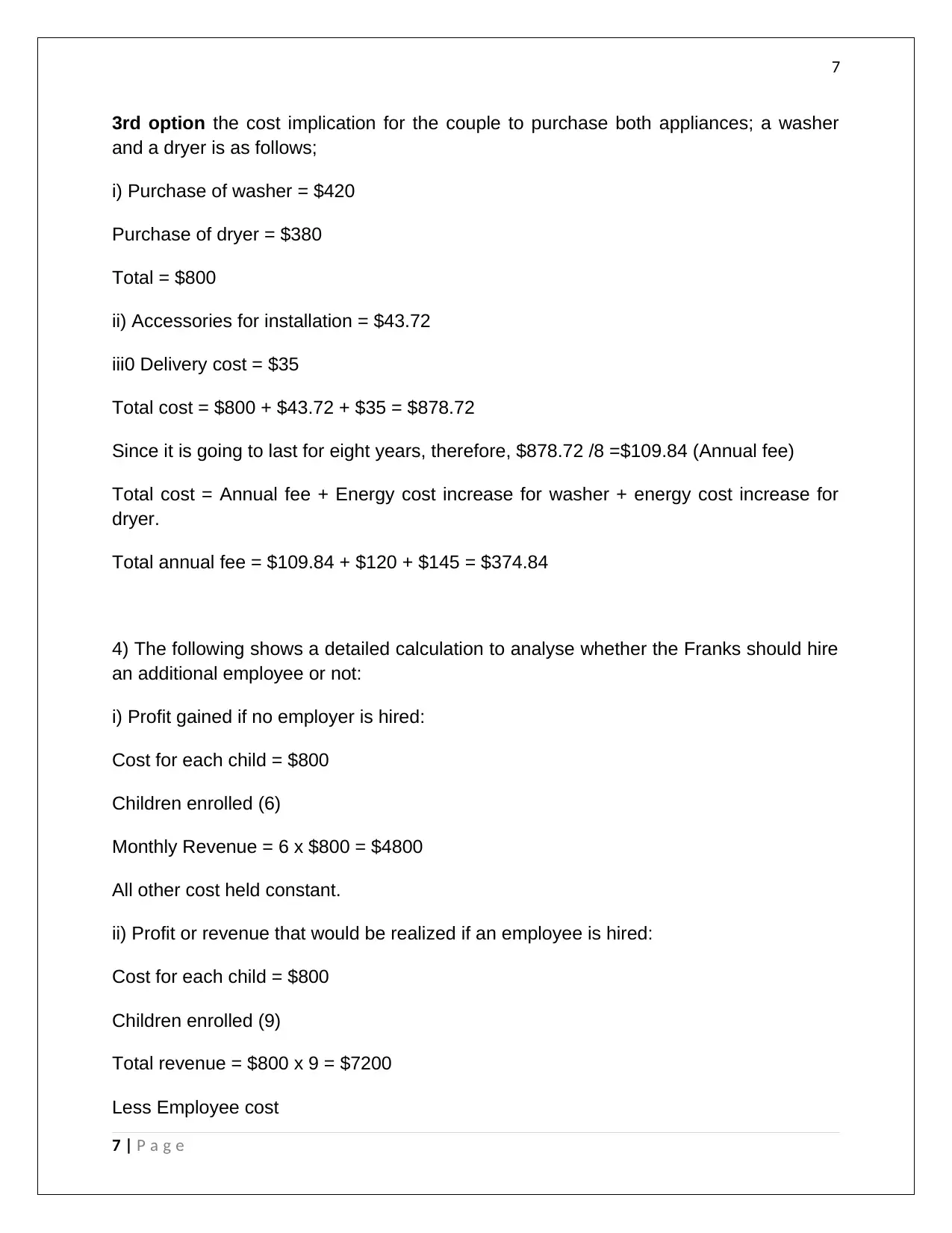
7
3rd option the cost implication for the couple to purchase both appliances; a washer
and a dryer is as follows;
i) Purchase of washer = $420
Purchase of dryer = $380
Total = $800
ii) Accessories for installation = $43.72
iii0 Delivery cost = $35
Total cost = $800 + $43.72 + $35 = $878.72
Since it is going to last for eight years, therefore, $878.72 /8 =$109.84 (Annual fee)
Total cost = Annual fee + Energy cost increase for washer + energy cost increase for
dryer.
Total annual fee = $109.84 + $120 + $145 = $374.84
4) The following shows a detailed calculation to analyse whether the Franks should hire
an additional employee or not:
i) Profit gained if no employer is hired:
Cost for each child = $800
Children enrolled (6)
Monthly Revenue = 6 x $800 = $4800
All other cost held constant.
ii) Profit or revenue that would be realized if an employee is hired:
Cost for each child = $800
Children enrolled (9)
Total revenue = $800 x 9 = $7200
Less Employee cost
7 | P a g e
3rd option the cost implication for the couple to purchase both appliances; a washer
and a dryer is as follows;
i) Purchase of washer = $420
Purchase of dryer = $380
Total = $800
ii) Accessories for installation = $43.72
iii0 Delivery cost = $35
Total cost = $800 + $43.72 + $35 = $878.72
Since it is going to last for eight years, therefore, $878.72 /8 =$109.84 (Annual fee)
Total cost = Annual fee + Energy cost increase for washer + energy cost increase for
dryer.
Total annual fee = $109.84 + $120 + $145 = $374.84
4) The following shows a detailed calculation to analyse whether the Franks should hire
an additional employee or not:
i) Profit gained if no employer is hired:
Cost for each child = $800
Children enrolled (6)
Monthly Revenue = 6 x $800 = $4800
All other cost held constant.
ii) Profit or revenue that would be realized if an employee is hired:
Cost for each child = $800
Children enrolled (9)
Total revenue = $800 x 9 = $7200
Less Employee cost
7 | P a g e
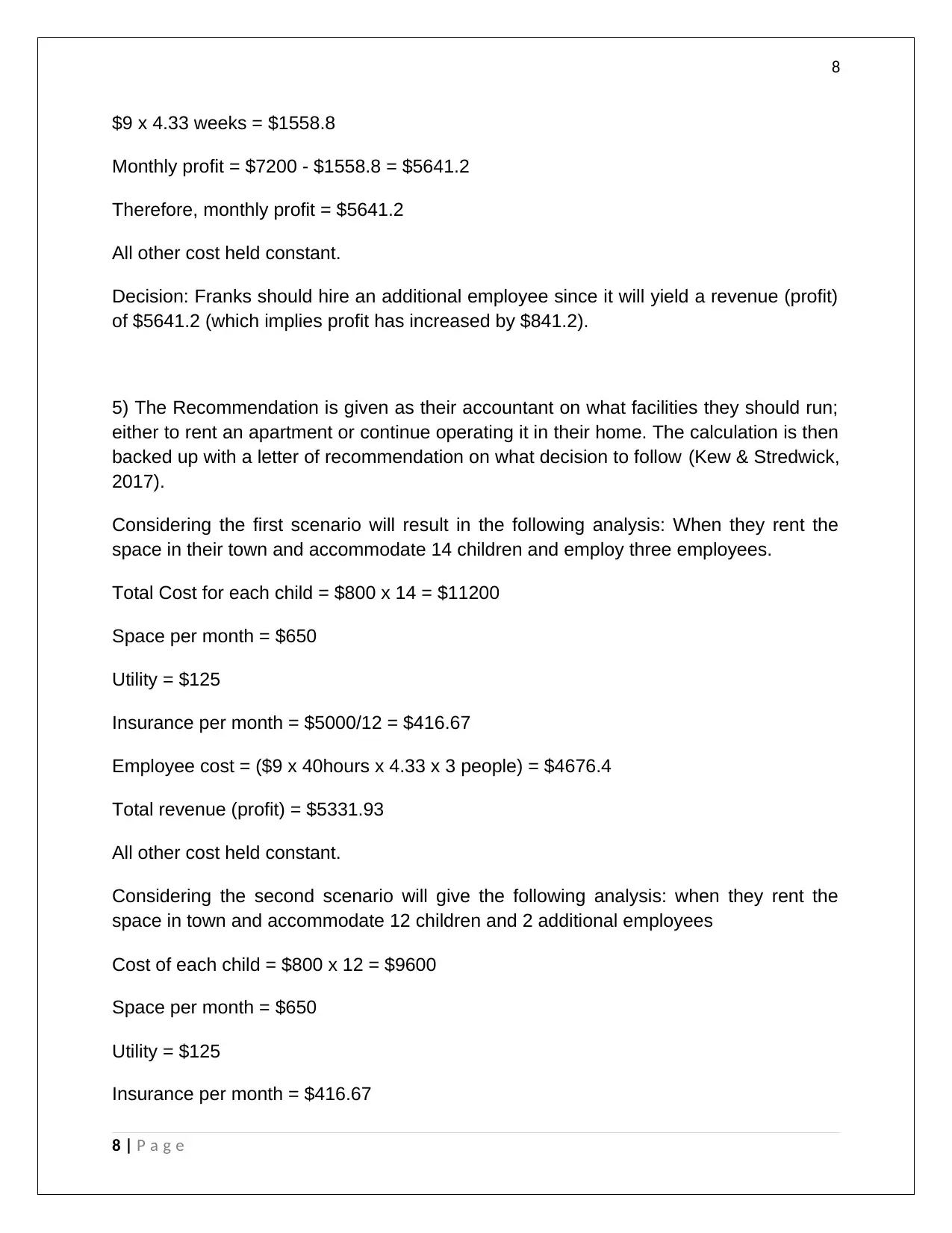
8
$9 x 4.33 weeks = $1558.8
Monthly profit = $7200 - $1558.8 = $5641.2
Therefore, monthly profit = $5641.2
All other cost held constant.
Decision: Franks should hire an additional employee since it will yield a revenue (profit)
of $5641.2 (which implies profit has increased by $841.2).
5) The Recommendation is given as their accountant on what facilities they should run;
either to rent an apartment or continue operating it in their home. The calculation is then
backed up with a letter of recommendation on what decision to follow (Kew & Stredwick,
2017).
Considering the first scenario will result in the following analysis: When they rent the
space in their town and accommodate 14 children and employ three employees.
Total Cost for each child = $800 x 14 = $11200
Space per month = $650
Utility = $125
Insurance per month = $5000/12 = $416.67
Employee cost = ($9 x 40hours x 4.33 x 3 people) = $4676.4
Total revenue (profit) = $5331.93
All other cost held constant.
Considering the second scenario will give the following analysis: when they rent the
space in town and accommodate 12 children and 2 additional employees
Cost of each child = $800 x 12 = $9600
Space per month = $650
Utility = $125
Insurance per month = $416.67
8 | P a g e
$9 x 4.33 weeks = $1558.8
Monthly profit = $7200 - $1558.8 = $5641.2
Therefore, monthly profit = $5641.2
All other cost held constant.
Decision: Franks should hire an additional employee since it will yield a revenue (profit)
of $5641.2 (which implies profit has increased by $841.2).
5) The Recommendation is given as their accountant on what facilities they should run;
either to rent an apartment or continue operating it in their home. The calculation is then
backed up with a letter of recommendation on what decision to follow (Kew & Stredwick,
2017).
Considering the first scenario will result in the following analysis: When they rent the
space in their town and accommodate 14 children and employ three employees.
Total Cost for each child = $800 x 14 = $11200
Space per month = $650
Utility = $125
Insurance per month = $5000/12 = $416.67
Employee cost = ($9 x 40hours x 4.33 x 3 people) = $4676.4
Total revenue (profit) = $5331.93
All other cost held constant.
Considering the second scenario will give the following analysis: when they rent the
space in town and accommodate 12 children and 2 additional employees
Cost of each child = $800 x 12 = $9600
Space per month = $650
Utility = $125
Insurance per month = $416.67
8 | P a g e
⊘ This is a preview!⊘
Do you want full access?
Subscribe today to unlock all pages.

Trusted by 1+ million students worldwide
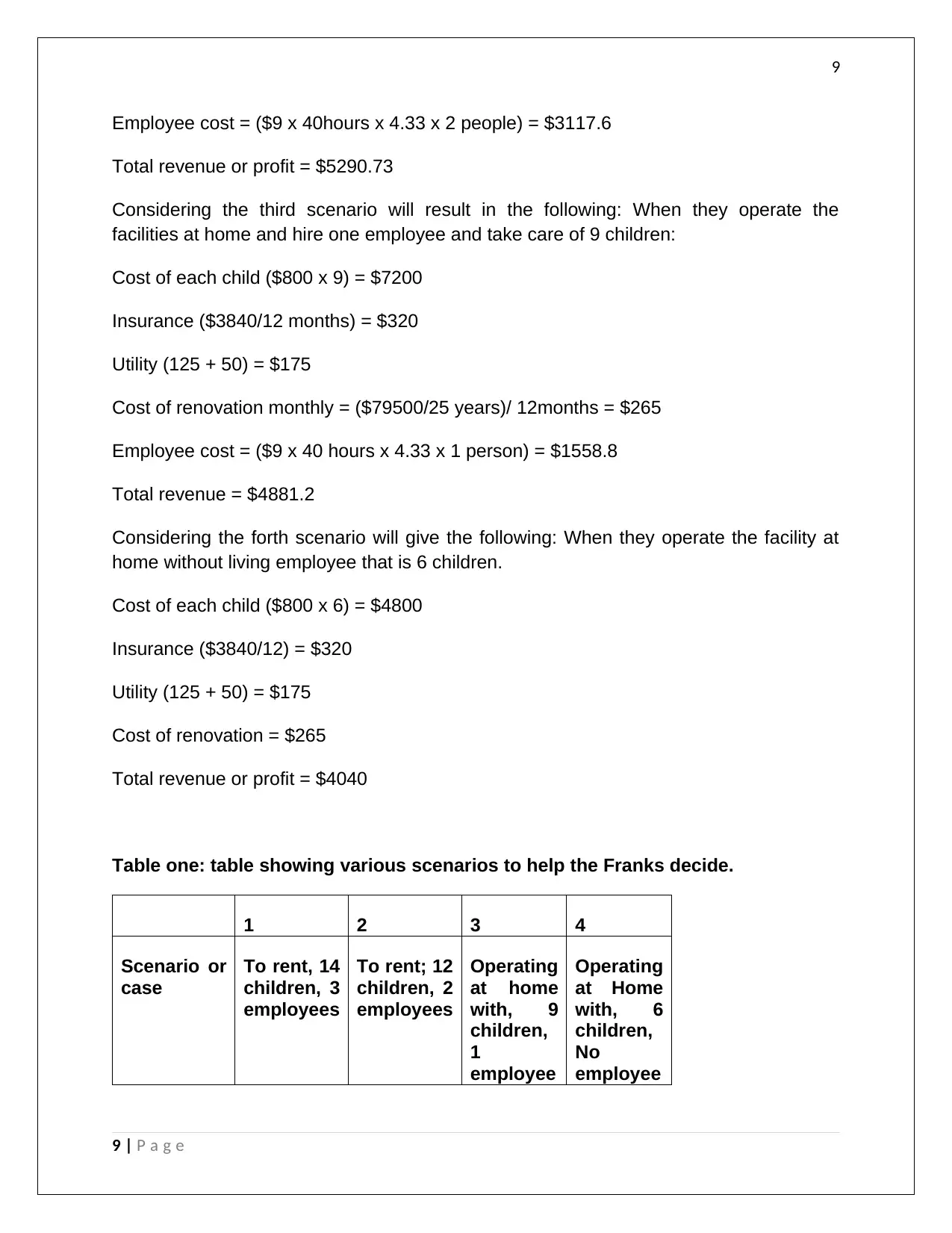
9
Employee cost = ($9 x 40hours x 4.33 x 2 people) = $3117.6
Total revenue or profit = $5290.73
Considering the third scenario will result in the following: When they operate the
facilities at home and hire one employee and take care of 9 children:
Cost of each child ($800 x 9) = $7200
Insurance ($3840/12 months) = $320
Utility (125 + 50) = $175
Cost of renovation monthly = ($79500/25 years)/ 12months = $265
Employee cost = ($9 x 40 hours x 4.33 x 1 person) = $1558.8
Total revenue = $4881.2
Considering the forth scenario will give the following: When they operate the facility at
home without living employee that is 6 children.
Cost of each child ($800 x 6) = $4800
Insurance ($3840/12) = $320
Utility (125 + 50) = $175
Cost of renovation = $265
Total revenue or profit = $4040
Table one: table showing various scenarios to help the Franks decide.
1 2 3 4
Scenario or
case
To rent, 14
children, 3
employees
To rent; 12
children, 2
employees
Operating
at home
with, 9
children,
1
employee
Operating
at Home
with, 6
children,
No
employee
9 | P a g e
Employee cost = ($9 x 40hours x 4.33 x 2 people) = $3117.6
Total revenue or profit = $5290.73
Considering the third scenario will result in the following: When they operate the
facilities at home and hire one employee and take care of 9 children:
Cost of each child ($800 x 9) = $7200
Insurance ($3840/12 months) = $320
Utility (125 + 50) = $175
Cost of renovation monthly = ($79500/25 years)/ 12months = $265
Employee cost = ($9 x 40 hours x 4.33 x 1 person) = $1558.8
Total revenue = $4881.2
Considering the forth scenario will give the following: When they operate the facility at
home without living employee that is 6 children.
Cost of each child ($800 x 6) = $4800
Insurance ($3840/12) = $320
Utility (125 + 50) = $175
Cost of renovation = $265
Total revenue or profit = $4040
Table one: table showing various scenarios to help the Franks decide.
1 2 3 4
Scenario or
case
To rent, 14
children, 3
employees
To rent; 12
children, 2
employees
Operating
at home
with, 9
children,
1
employee
Operating
at Home
with, 6
children,
No
employee
9 | P a g e
Paraphrase This Document
Need a fresh take? Get an instant paraphrase of this document with our AI Paraphraser
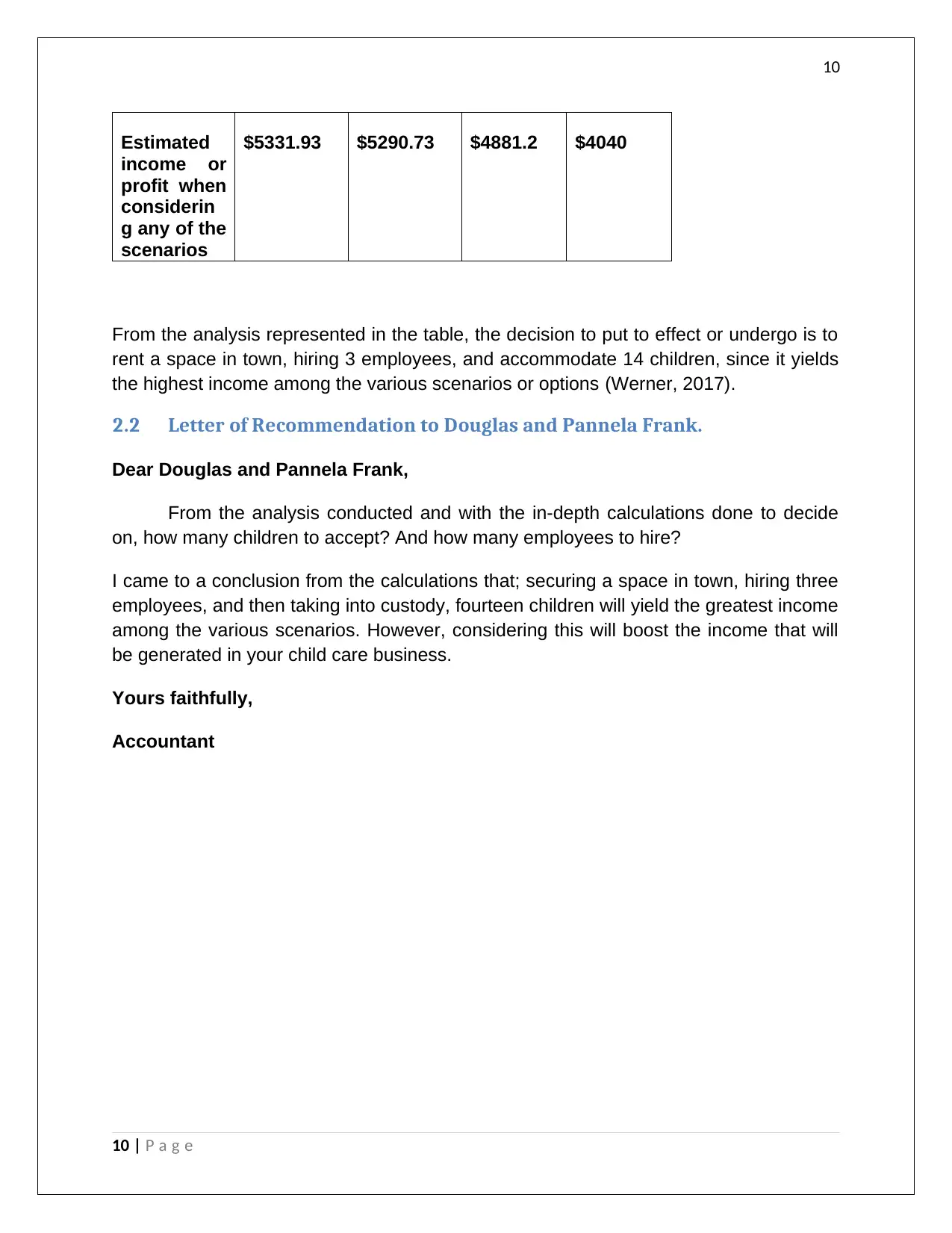
10
Estimated
income or
profit when
considerin
g any of the
scenarios
$5331.93 $5290.73 $4881.2 $4040
From the analysis represented in the table, the decision to put to effect or undergo is to
rent a space in town, hiring 3 employees, and accommodate 14 children, since it yields
the highest income among the various scenarios or options (Werner, 2017).
2.2 Letter of Recommendation to Douglas and Pannela Frank.
Dear Douglas and Pannela Frank,
From the analysis conducted and with the in-depth calculations done to decide
on, how many children to accept? And how many employees to hire?
I came to a conclusion from the calculations that; securing a space in town, hiring three
employees, and then taking into custody, fourteen children will yield the greatest income
among the various scenarios. However, considering this will boost the income that will
be generated in your child care business.
Yours faithfully,
Accountant
10 | P a g e
Estimated
income or
profit when
considerin
g any of the
scenarios
$5331.93 $5290.73 $4881.2 $4040
From the analysis represented in the table, the decision to put to effect or undergo is to
rent a space in town, hiring 3 employees, and accommodate 14 children, since it yields
the highest income among the various scenarios or options (Werner, 2017).
2.2 Letter of Recommendation to Douglas and Pannela Frank.
Dear Douglas and Pannela Frank,
From the analysis conducted and with the in-depth calculations done to decide
on, how many children to accept? And how many employees to hire?
I came to a conclusion from the calculations that; securing a space in town, hiring three
employees, and then taking into custody, fourteen children will yield the greatest income
among the various scenarios. However, considering this will boost the income that will
be generated in your child care business.
Yours faithfully,
Accountant
10 | P a g e
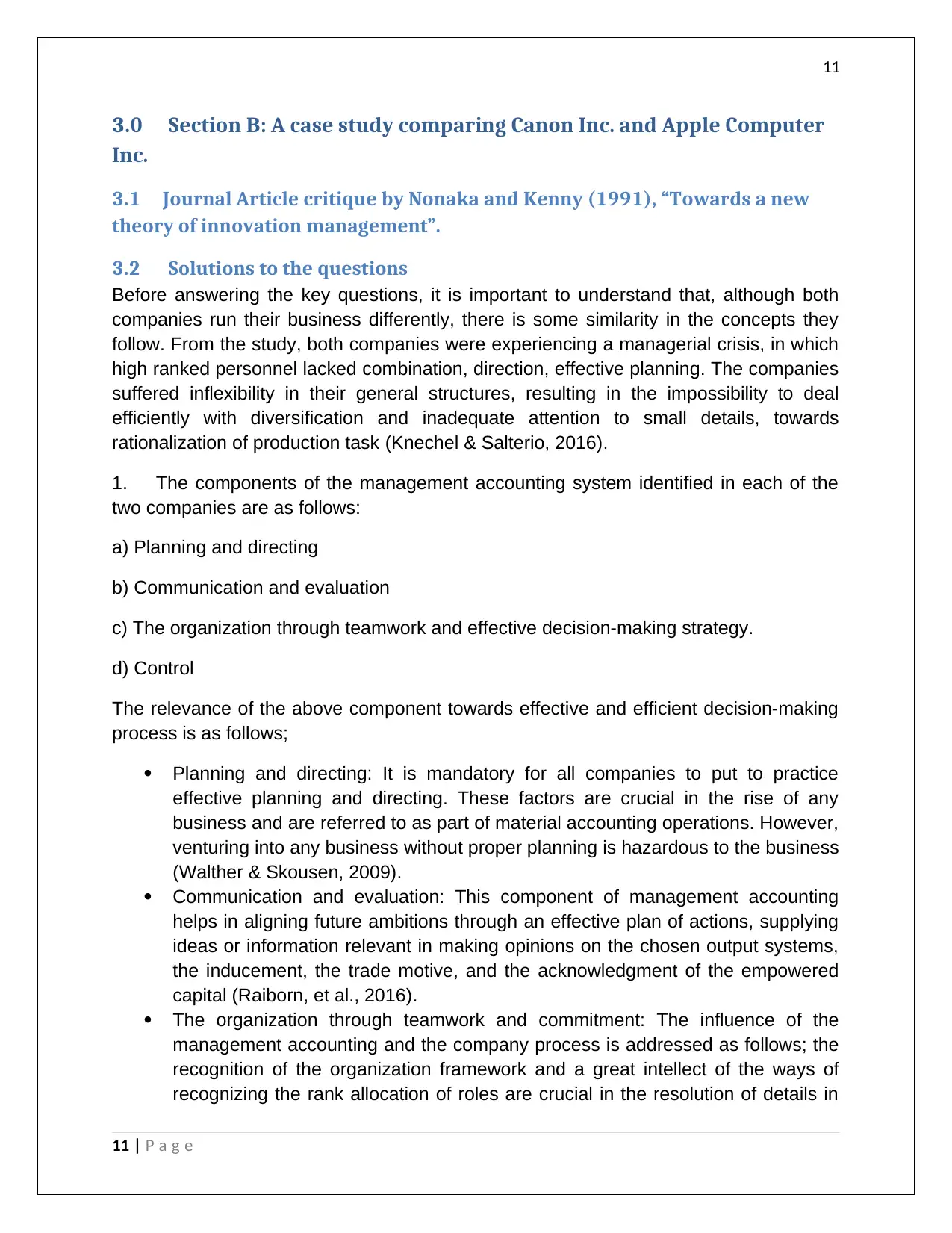
11
3.0 Section B: A case study comparing Canon Inc. and Apple Computer
Inc.
3.1 Journal Article critique by Nonaka and Kenny (1991), “Towards a new
theory of innovation management”.
3.2 Solutions to the questions
Before answering the key questions, it is important to understand that, although both
companies run their business differently, there is some similarity in the concepts they
follow. From the study, both companies were experiencing a managerial crisis, in which
high ranked personnel lacked combination, direction, effective planning. The companies
suffered inflexibility in their general structures, resulting in the impossibility to deal
efficiently with diversification and inadequate attention to small details, towards
rationalization of production task (Knechel & Salterio, 2016).
1. The components of the management accounting system identified in each of the
two companies are as follows:
a) Planning and directing
b) Communication and evaluation
c) The organization through teamwork and effective decision-making strategy.
d) Control
The relevance of the above component towards effective and efficient decision-making
process is as follows;
Planning and directing: It is mandatory for all companies to put to practice
effective planning and directing. These factors are crucial in the rise of any
business and are referred to as part of material accounting operations. However,
venturing into any business without proper planning is hazardous to the business
(Walther & Skousen, 2009).
Communication and evaluation: This component of management accounting
helps in aligning future ambitions through an effective plan of actions, supplying
ideas or information relevant in making opinions on the chosen output systems,
the inducement, the trade motive, and the acknowledgment of the empowered
capital (Raiborn, et al., 2016).
The organization through teamwork and commitment: The influence of the
management accounting and the company process is addressed as follows; the
recognition of the organization framework and a great intellect of the ways of
recognizing the rank allocation of roles are crucial in the resolution of details in
11 | P a g e
3.0 Section B: A case study comparing Canon Inc. and Apple Computer
Inc.
3.1 Journal Article critique by Nonaka and Kenny (1991), “Towards a new
theory of innovation management”.
3.2 Solutions to the questions
Before answering the key questions, it is important to understand that, although both
companies run their business differently, there is some similarity in the concepts they
follow. From the study, both companies were experiencing a managerial crisis, in which
high ranked personnel lacked combination, direction, effective planning. The companies
suffered inflexibility in their general structures, resulting in the impossibility to deal
efficiently with diversification and inadequate attention to small details, towards
rationalization of production task (Knechel & Salterio, 2016).
1. The components of the management accounting system identified in each of the
two companies are as follows:
a) Planning and directing
b) Communication and evaluation
c) The organization through teamwork and effective decision-making strategy.
d) Control
The relevance of the above component towards effective and efficient decision-making
process is as follows;
Planning and directing: It is mandatory for all companies to put to practice
effective planning and directing. These factors are crucial in the rise of any
business and are referred to as part of material accounting operations. However,
venturing into any business without proper planning is hazardous to the business
(Walther & Skousen, 2009).
Communication and evaluation: This component of management accounting
helps in aligning future ambitions through an effective plan of actions, supplying
ideas or information relevant in making opinions on the chosen output systems,
the inducement, the trade motive, and the acknowledgment of the empowered
capital (Raiborn, et al., 2016).
The organization through teamwork and commitment: The influence of the
management accounting and the company process is addressed as follows; the
recognition of the organization framework and a great intellect of the ways of
recognizing the rank allocation of roles are crucial in the resolution of details in
11 | P a g e
⊘ This is a preview!⊘
Do you want full access?
Subscribe today to unlock all pages.

Trusted by 1+ million students worldwide
1 out of 16
Related Documents
Your All-in-One AI-Powered Toolkit for Academic Success.
+13062052269
info@desklib.com
Available 24*7 on WhatsApp / Email
![[object Object]](/_next/static/media/star-bottom.7253800d.svg)
Unlock your academic potential
Copyright © 2020–2025 A2Z Services. All Rights Reserved. Developed and managed by ZUCOL.





